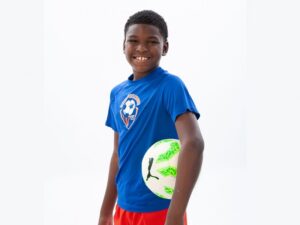Cleats are being laced up again, grass stains are set to return to those pristine soccer uniforms, and the Friday night lights will be shining once more as sports makes its long-awaited return. Coming off of a year of isolation, cancelled sports, and quarantining, children have been missing the social interactions that sports provide.
Children love to run and do all things that require lots of energy and engage their minds. As their parents who have been stuck in quarantine with them, we understand just how much energy they have. However, their love for competition and mimicking their favorite pro athletes is real. Now, they get the chance to do that again.
We spent so long keeping them safe at home that it’s hard not to be concerned about their safety even more than before. The world is such an unpredictable place. With a pandemic and so much potential for sports injuries, it is understandable why the concern is there. However, playing it safe is possible in sports.
Why Are Sports Good?
Sports play a very important role in the lives of children. Dr. Jeremy Burnham, an orthopedic surgeon at Ochsner Health, shares, “The overall benefits of sports participation is so high; it teaches kids so many lessons and benefits their physical and mental health and fosters
friendships.”
Dr. Dawn Vick, a doctor of pediatric medicine at The Baton Rouge Clinic, puts an emphasis on the importance of sports for children. “They need sports and recreation for optimal growth and development, while also understanding competition and how to be good at both winning and losing. These are all important life lessons,” she says.
Medical professionals often agree on the importance of sports, but they also agree that injuries are a part of it, and knowing how to take care of children while they partake in these sports is just as important.
What Injuries Are Common?
Dr. Burnham understands parents’ concerns very well. He shares just how important it is for parents to be observant when it comes to sports injuries. Small problems that may not seem like a big deal at first have the potential to worsen if left untreated. That is why it is important to know your child.
It is also important to get a physical completed. This will help to catch problems that could be worsened by sports. There are potential life-threatening health problems that could ultimately mean the end of their playing career. These physicals help to identify these issues now, before they become a threatening one on the field. Parents should seek wisdom from their child’s pediatrician regarding physicals and sports.
Dr. Vick points out many common sports injuries that she observes on a daily basis, including ankle sprains, ACL tears, shin splints, turf toe, and spondylolysis. Some of these can be handled at home with supportive care and observation, but parents should exercise discernment when it comes to major problems and seek professional help.
One thing that Dr. Burnham emphasizes is the conditioning level of these children and their acclimation to the heat. It is really important to gradually reintroduce children into sports again after an extended period without it. Heat is a very serious thing, especially in Louisiana, and making sure children are properly hydrated is important. Being on the lookout for symptoms like dizziness, drowsiness, and fatigue is vital. This is not a new problem by any means, but it is one that the pandemic affects. Children are coming from an extended hiatus where they didn’t have access to organized sports. Their bodies are not used to it just yet, so parents need to slowly reintroduce sports to their kids while keeping a keen eye out for symptoms of heat exhaustion.
Another serious injury that Dr. Burnham highlights is concussions. It is important to realize that concussions do not only occur in contact sports. The child also does not need to lose consciousness to warrant a concussion. Parents should be on the lookout for symptoms such as headaches, confusion, and drowsiness. A concussion is treatable, but it needs to be caught early.
Can We Prevent Them?
Unfortunately, a parent can never fully protect their child from injury. There isn’t a magic way to make the risk for injury zero percent, but there are things that can be done to help these percentages. Dr. Vick explains, “Some practical things parents can do to prevent injury include good hydration and a well-balanced diet, rest and good sleep habits, stretching adequately before and after exercise or practice, knowing the rules of the game, not playing when sick or injured, and encouraging cross training with a variety of sports. This is important so the same muscle groups are not overused and there’s less risk for injury.”
A benefit to this is that parents know their child better than anyone else. They should follow their gut and seek medical attention at their discretion. With heat exhaustion and concussions in particular, if there is any suspicion then parents should get it checked out.
Should They Do Something Else?
Despite the risk for injury, it doesn’t mean your child shouldn’t participate. Dr. Burnham states, “It is important to realize anything we do in life has risks; we have to weigh the pros and cons and there are so many benefits to sports. The pros outweigh the cons, but you need to do it safely. You can’t make the risk of injury zero percent. As we navigate this world, we should be very deliberate in finding ways for children to be active and participate in sports.”
Finding a healthy way for kids to participate while putting an emphasis on gradual acclimation is a must in order to provide children with this healthy outlet. Withholding a child would ultimately do more harm than good.





